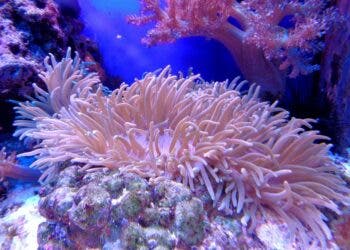
According to NOAA’s Coral Reef Ecosystem Division about 30 percent of the world’s coral population has perished due to average ocean temperatures, El Nino’s effects and acidification. Even if we halt all man-made CO2 emissions now (virtually impossible), the cascading effects of ocean acidification can not be halted once they’ve been set in motion. As a result, coral all over the world will bleach more frequently and intensely. Desperate times indeed, but a group of scientists are trying their best. They identified strong coral specimens and are currently stressing them further so they become more resiliant to changing conditions driven by global warming. In time, these super coral might be transferred all over the globe in an attempt to halt the rapidly deteriorating coral reef.
An acid ocean
Around half of all carbon dioxide produced by humans since the industrial revolution has dissolved into the world’s oceans, which act like huge carbon sinks, along with forests. As such, much of the damage of increased CO2 levels in the atmosphere is actually felt under water. When carbon dioxide (CO2) is absorbed by seawater, chemical reactions occur that reduce seawater pH, carbonate ion concentration, and saturation states of biologically important calcium carbonate minerals. This severely impacts the ability of some organisms to produce and maintain their shell. More and more studies suggest some calcifying species, including oysters, clams, sea urchins, shallow water corals, deep sea corals, and calcareous plankton, are dramatically affected by ocean acidification.
Since the industrial revolution, the pH of surface ocean waters has fallen by 0.1 pH units. Since the pH scale is logarithmic this entails a 30 percent increase in acidity. Climate models suggest that under a business as usual scenario, i.e we continue on our upward trend of CO2 emissions, then the oceans could become nearly 150 percent more acidic by the end of the century. These conditions haven’t been experienced for the past 20 million years, NOAA warns.
White coral
Concerning coral, which comprise habitats for marine life, protect shorelines and drive tourist economies, it seems to be particularly vulnerable to ocean acidificaiton. When coral is stressed by environmental conditions like an acid environment, the symbiotic algae that live within it is expelled and the animal turns white or bright yellow. This is bleaching. The phenomena doesn’t kill the coral per se, but long term bleaching will.
“We may be looking at losing somewhere in the range of 10 to 20 percent of the coral reefs this year,” NOAA coral reef watch coordinator Mark Eakin said when the report was released. “Hawaii is getting hit with the worst coral bleaching they have ever seen.”
To address this worrisome issue, researchers at University of Hawaii at Manoa are turning to creative solutions. “Not all corals are created equal,” Ruth Gates, director of UH Manoa’s Hawaii Institute of Marine Biology, said in a statement. “We will capitalize on those corals that already show a stronger ability to withstand the changing ocean environment and their capacity to pass this resilience along to new generations.”
The times of the fittest
What Gates is referring to is nothing but selective breeding or assisted evolution. They bathe chunks of coral that they’ve already identified as having strong genes in water that mimics the warmer and more acidic oceans. They then take resilient strains and breed them with one another to produce similarly strong offspring. Sounds familiar? Well, this has been going on for thousands of years. This is how we now have tomatoes, onions or corn. These look nothing like the wild variety and have been carefully selected by humans since the advent of agriculture. Hence, what Gates and colleagues are doing should not be confused with genetically modified organisms where foreign genes are introduced in a host organism.
Gates is working on this solution in his lab on the 28-acre Coconut Island, in Kaneohe Bay. Gates estimated that about 60 to 80 percent of the coral in Kaneohe Bay has bleached this year, so he and the rest of the team hope to transfer the super coral to the area as soon as possible. Migrating super coral to other parts of the world, however, might prove exceedingly difficult. In some instances, it would be too late already. “The question is not can they do it, it’s can they do it fast enough?” said Tom Oliver, a marine biologist and team leader at NOAA’s Coral Reef Ecosystem Division.
Hokulea crew and UH researchers explore Great Barrier Reef from University of Hawai'i System on Vimeo.






